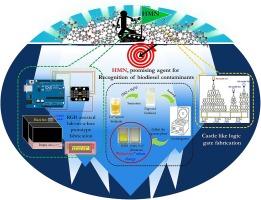Real time monitoring of heavy metal adulteration in biodiesel using Arduino UNO platform@A promising multi-purpose stimuli-responsive azomethine based chemoreceptor for hierarchical tri-ionic sensing
IF 4.9
2区 化学
Q1 CHEMISTRY, ANALYTICAL
引用次数: 0
Abstract
The presence of metallic adulteration even in very trace level may lead to deleterious impact on the biodiesel quality and ultimately may be responsible for the dropping down of system efficiency, which necessitates the trace level recognition of heavy metal adulteration from biodiesel. In this context, herein using an azomethine functionalized chromogenic chemoreceptor, 1-((E)-(4-hydroxyphenylimino) methyl) napthalen-2-ol (HMN) has been reported for the selective chemodosimetric recognition of Cu2+ with a lower detection threshold of 7.8 ppb via distinct chromogenic variation of HMN. In addition to this, it has also exhibited selective and reversible naked eye chromogenic sensing behaviour towards F− (LOD=160 ppb) and Al3+ (LOD=48 ppb) at very trace level, which is quite lower than the WHO permissible limit. Distinct chromogenic recognition of F− by HMN proceeds via strong intermolecular hydrogen bonding mediated improved intramolecular charge transfer. The spectroscopic response of HMN in alternate presence and absence of the targeted analytes made it suitable to formulate AND-NOT-XNOR-NAND-OR gate based ‘Castle-like’ complicated logic circuitry. In-vitro cell imaging study using A549, human lung carcinoma cell line attests intracellular recognition capability of HMN, demonstrating its effectual bio-medicinal applications. Interestingly, inspired by the capability of HMN towards recognition of copper from biodiesel specimen, an RGB-assisted device comprised of TCS color sensor and an Arduino UNO 8-bit microcontroller has been developed for real-time quantitative analysis of the biodiesel adulteration. Going one step further, utilization of lab-on-a-box based prototype to monitor the concentration-dependent chromogenic fluctuation via RGB analysis is undoubtedly beneficial for the determination of copper adulteration in biodiesel sample. The presently developed chemoreceptor can thus be regarded as a valuable addition in the field of supramolecular chemistry as well as a significant initiative towards regular monitoring of the biodiesel quality control parameters as a part of sustainable environment.

利用 Arduino UNO 平台实时监测生物柴油中的重金属掺假@一种用于分层三离子传感的前景广阔的多用途刺激响应型偶氮金属化学感受器
金属掺杂物的存在,即使是非常痕量的掺杂物,也可能会对生物柴油的质量产生有害影响,并最终导致系统效率下降,因此有必要从生物柴油中识别痕量的重金属掺杂物。在此背景下,有报告称使用偶氮甲基官能化色原化学感受器 1-((E)-(4-羟基苯基亚氨基)甲基)萘-2-醇(HMN),通过 HMN 的独特色原变化,以较低的 7.8 ppb 检测阈值选择性识别 Cu2+。此外,它还对痕量水平的 F-(LOD=160ppb)和 Al3+(LOD=48ppb)表现出选择性和可逆性的肉眼显色传感行为,这远低于世界卫生组织的允许限值。HMN 通过强分子间氢键介导的分子内电荷转移对 F- 进行独特的显色识别。HMN 在目标分析物存在和不存在时的光谱响应使其适合于配制基于 "类城堡 "复杂逻辑电路的 AND-NOT-XNOR-NAND-OR 门。使用 A549 人肺癌细胞系进行的体外细胞成像研究证明了 HMN 的细胞内识别能力,证明了其生物医学应用的有效性。有趣的是,受 HMN 识别生物柴油样本中铜的能力的启发,我们开发了一种由 TCS 颜色传感器和 Arduino UNO 8 位微控制器组成的 RGB 辅助设备,用于生物柴油掺假的实时定量分析。更进一步说,利用基于盒上实验室的原型,通过 RGB 分析来监测随浓度变化的色度波动,无疑有利于测定生物柴油样品中的铜掺假情况。因此,目前开发的化学感受器可被视为超分子化学领域的宝贵补充,也是定期监测生物柴油质量控制参数的重要举措,是可持续环境的一部分。
本文章由计算机程序翻译,如有差异,请以英文原文为准。
求助全文
约1分钟内获得全文
求助全文
来源期刊

Microchemical Journal
化学-分析化学
CiteScore
8.70
自引率
8.30%
发文量
1131
审稿时长
1.9 months
期刊介绍:
The Microchemical Journal is a peer reviewed journal devoted to all aspects and phases of analytical chemistry and chemical analysis. The Microchemical Journal publishes articles which are at the forefront of modern analytical chemistry and cover innovations in the techniques to the finest possible limits. This includes fundamental aspects, instrumentation, new developments, innovative and novel methods and applications including environmental and clinical field.
Traditional classical analytical methods such as spectrophotometry and titrimetry as well as established instrumentation methods such as flame and graphite furnace atomic absorption spectrometry, gas chromatography, and modified glassy or carbon electrode electrochemical methods will be considered, provided they show significant improvements and novelty compared to the established methods.
 求助内容:
求助内容: 应助结果提醒方式:
应助结果提醒方式:


